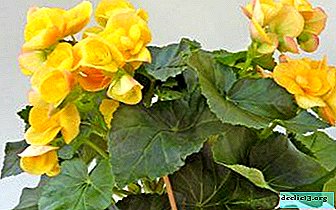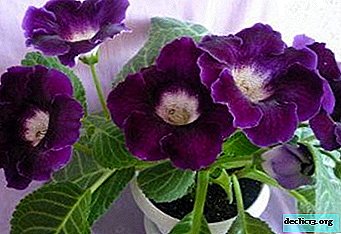Tips from experienced gardeners: how to transplant an orchid into another pot?

Sooner or later, any grower has to deal with plant transplants. It is also important for their health, like watering, lighting and caring.
To transplant an orchid into another pot at home, you must first choose it correctly and know the subtleties of the transplant process itself.
Is it necessary to transplant the plant into a larger pot, is it possible to transplant, for example, into a glass container or better still into an opaque one? We will learn about this in the article.
Do I need a change from a small to a large flowerpot?
Transplants are usually performed once a year. and the best time for this is spring. The flower needs to be replanted, because it grows, grows in size and it becomes crowded in the old pot. As well, the soil is depleted and needs to be replaced, since the plant draws out useful microelements from it for its vital functions.
Therefore, if the plant has not been transplanted for several years, or it has grown and its roots peek out from the drainage holes, then it is necessary to transplant into another pot, larger than the previous one.
Advice! If the plant withers and blooms poorly, then perhaps he needs to replace the soil, so you can transplant it into an old pot.How to choose the right capacity for the flower?
When choosing a pot, it must be borne in mind that most of the orchids are epiphytes, or lithophytes, who do not like the waterlogging of the roots. Therefore, the pot for orchids is not so much a container for the roots, but a stand. If you want a decorative effect, you can put the pot in a pot, this will give the beautiful plant even more attractiveness.
What to look for?
 Orchid pot must provide:
Orchid pot must provide:
- sufficient outflow of moisture;
- air access to the root system and soil;
- safe removal for further transplantation.
Therefore, when choosing, it is necessary to pay attention to containers with a large number of drainage holes and it is desirable that they are present on its side walls. And also on those where the height of the container is equal to the width, so that the flower that grows and scrambles up does not turn over with the container. Of course, you need a pot that is suitable in size to fit in the root system of the plant.
Reference! As for the material, the pots are clay, glass and plastic.Glass pots are good for those types of orchids whose roots take part in photosynthesis, as the sun's rays penetrate well into the root system. But glass pots may have only one or more drainage holes, and this can lead to stagnation of moisture.
Clay pots should not be taken, since the rhizomes are tightly attached to the rough surface of the ceramics, as a result of which injuries during subsequent transplantation are possible. They also have no access to the roots of the sun. But there are also advantages of such pots - they are permeable to water and air, moisture in them is evenly distributed and does not stagnate.
The most suitable and common pot is plastic. They come in any color and taste, and for orchids you can choose a transparent one. It is also good that they have several drain holes from the bottom, and if they are lacking, the owner of the flower can do the necessary amount without harm to the plant and pot.
Step-by-step transplant instructions
It is not enough to choose a suitable pot, you still need to be able to properly transplant without harming the plant. Regardless of what capacity and size (larger or smaller than the previous one) the flower is transplanted, it is necessary to follow the same rules and steps when transplanting.
First you need to prepare the necessary inventory:
- A pot of larger or smaller volume, depending on what the purpose of the transplant is and the type of flower.
- Taz.
 Substrate.
Substrate.- Drainage (expanded clay, ceramic shards).
- Sanitized scissors or pruners.
- Antiseptic (charcoal or activated carbon).
- Moss Sphagnum.
- Stick for pushing the substrate between the roots.
- The peduncle holder.
- Fitosporin to carry out fungal prophylaxis.
Next, the plant itself is prepared for transplantation:
- You need to carefully pull out the orchid. To do this, hold the plant at the base of the stem, and the pot upside down.
- To remove residual substrate, either simply crushing it, or rinsing with water.
- Inspect the roots and in the presence of dry or rotten remove. Also cut old peduncles and yellowed leaves.
- Immerse the roots in a solution of Fitosporin for 30-40 minutes.
- We dry the roots in the air for several hours.
- We process the places of the slices with an antiseptic prepared in advance.
Having prepared the flower according to the instructions, you can proceed to planting:
- At the bottom of the pot, put drainage with a layer of 2-4 cm.
- Put the flower in the center of the container, if there are peduncles, then we have a holder for them nearby.
- It is necessary to fill the roots with a substrate, pushing it with a stick between the roots.
- After filling the pot, put sphagnum moss on top.
Problems and difficulties
 It happens that the roots grow and the plant cannot be carefully removed, so if the plastic pot needs to be carefully cut.
It happens that the roots grow and the plant cannot be carefully removed, so if the plastic pot needs to be carefully cut.- Another difficulty is that the roots of the orchid are very fragile and easy to break, damaging the plant.
- It also often happens that the root system is so strongly intertwined that it does not work to remove the old substrate. Therefore, in this case, you need to move the earthen lump into a larger pot and add a new substrate.
Further plant care
Caring for a flower after a transplant is not very different from normal care.
- A healthy flower can be watered right away. But if you cut a lot of unusable roots, then it is advisable to simply spray the leaves with water.
- Also, at first it must be placed in a shaded, not hot place, protected from draft.
- After 10-14 days, it can be placed in normal conditions.
Related videos
Conclusion
Orchid is a very finicky flower, which requires special conditions for maintenance. The selection of a pot for planting a flower is quite significant. If you choose the wrong capacity, then the plant may stop blooming or even wither. But subject to all the necessary rules for transplanting and choosing a pot, your orchid will grow and delight the eye with its beauty.

 Substrate.
Substrate. It happens that the roots grow and the plant cannot be carefully removed, so if the plastic pot needs to be carefully cut.
It happens that the roots grow and the plant cannot be carefully removed, so if the plastic pot needs to be carefully cut.















